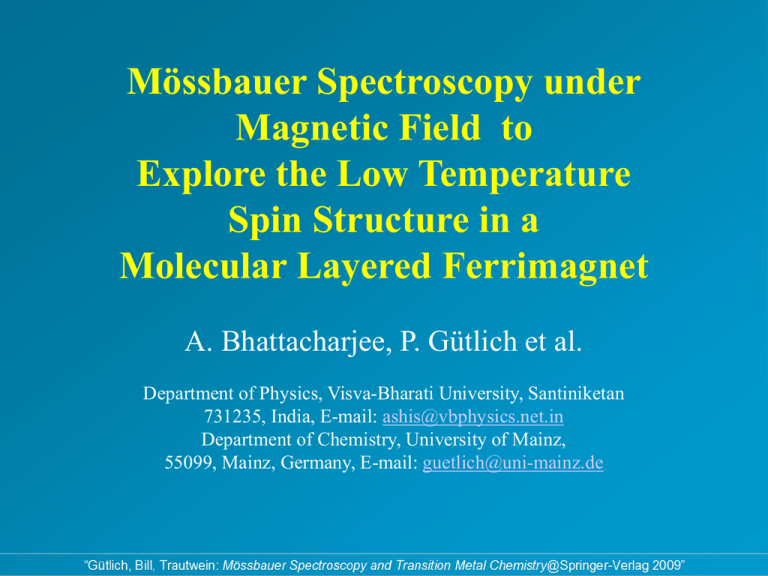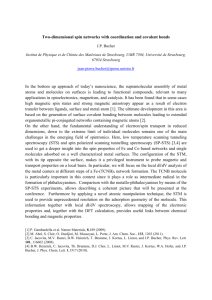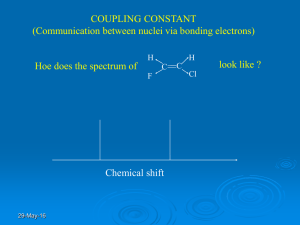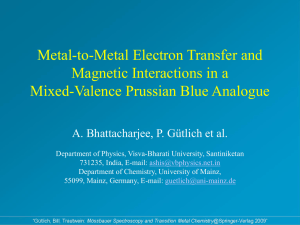Bhattacharjee_Layered Ferrimagnet.ppt
advertisement

Mössbauer Spectroscopy under
Magnetic Field to
Explore the Low Temperature
Spin Structure in a
Molecular Layered Ferrimagnet
A. Bhattacharjee, P. Gütlich et al.
Department of Physics, Visva-Bharati University, Santiniketan
731235, India, E-mail: ashis@vbphysics.net.in
Department of Chemistry, University of Mainz,
55099, Mainz, Germany, E-mail: guetlich@uni-mainz.de
{N(n-C4H9)4[FeIIFeIII(C2O4)3]}
A Molecular Ferrimagnet
The oxalato-bridged layered ferrimagnet {N(n-C4H9)4[FeIIFeIII(C2O4)3]} exhibits
the rarely occurring negative magnetization phenomenon below 30 K. Heat capacity
calorimetry of this compound under zero magnetic field detected the ferrimagnetic
transition at 43.3 K and a small heat capacity anomaly around 16.3 K. Results from the
magnetic field dependent heat capacity study of this material indicated the existence of
different spin structures at low temperatures. An ac magnetic susceptibility measurement
of this compound demonstrated the existence of a spin glass-like state below 30 K.
Mössbauer spectroscopy is a powerful tool for studying magnetic systems with
complicated magnetic structure, as this method offers the possibility to observe local spin
configurations of different types as well as provides the quantitative estimation of different
spin sites in a solid lattice. We have attempted to understand the origin of the spin glass
state in the present compound at low temperatures with the help of 57Fe Mössbauer
spectroscopy under high magnetic field.
For further details on this research problem see:
Bhattacharjee, et al., J. Phys. Soc. Jpn. 68 (1999) 1679.
Bhattacharjee, et al., J. Phys. Soc. Jpn. 69 (2000) 479.
Bhattacharjee, et al., Solid State Commun. 113 (2000) 543.
Bhattacharjee, et al., J. Phys. Soc. Jpn. 71 (2002) 2263.
Bhattacharjee, et al., J. Phys.: Condens. Matter 15 (2003) 5103.
Mössbauer Spectroscopy of
{N(n-C4H9)4[FeIIFeIII(C2O4)3]}
100
Fe
98
96
Fe
FeIII
Rel. Transmission (%)
Rel. Transmission (%)
100
II
94
Fe
III
C
Fe
II
Fe B
III
A
II
Fe A
96
94
H = 5 Tesla
T = 4.2 K
H = 0 Tesla
T = 4.2 K
92
-12
98
III
B
-8
-4
0
-1
v (mm s )
4
8
12
92
-12
-8
-4
0 -1
v (mm s )
Bhattacharjee, et al., J. Phys.: Condens. Matter 15 (2003) 5103.
4
8
12
Observation
Mössbauer spectroscopy of the molecular
ferrimagnet - {N(n-C4H9)4[FeIIFeIII(C2O4)3]}
under high external magnetic field at 4.2 K
successfully detected different types of FeII and
FeIII high spin sites in the lattices. The hyperfine
field values estimated for all the FeIII high spin
sites are close to the expected values, whereas
those for FeII high spin sites are substantially
different than usually expected.
A large fraction of magnetically disordered FeIII
high spin sites were found. It is understood that
the layered structure of the compound may have
two kinds of sub-lattices as (FeIIA-ox-FeIIIA-...)
and (FeIIB-ox-FeIIIB-...) along with randomly
placed magnetically disordered FeIIIC sites,
where
the
FeIIIA
and
FeIIIB
are
antiferromagnetically aligned. Existence of the
magnetically and/or structurally non-equivalent
spin sites in the same lattice has been held
responsible for the coexistence of different
ferrimagnetic interactions leading to the spin
glass state, as observed through earlier magnetic
and calorimetric measurements.
Schematic ferrimagnetic arrangement of
spins at different sites along c-axis in the
lattice. (solid arrow: FeIII spin, S = 5/2;
dashed arrow: FeII spin, S = 2).




